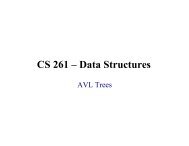Tufte's Design Principles III - Classes - Oregon State University
Tufte's Design Principles III - Classes - Oregon State University
Tufte's Design Principles III - Classes - Oregon State University
You also want an ePaper? Increase the reach of your titles
YUMPU automatically turns print PDFs into web optimized ePapers that Google loves.
Tu#e’s <strong>Design</strong> <strong>Principles</strong> <strong>III</strong> <br />
Ronald Metoyer <br />
Associate Professor <br />
<strong>Oregon</strong> <strong>State</strong> <strong>University</strong> <br />
Based on slides from John Stasko, GTECH
<strong>Design</strong> <strong>Principles</strong> <br />
Escape flatland – small multiples, parallel<br />
sequencing<br />
Data is multivariate<br />
Doesn’t necessarily mean 3D projection<br />
How can we enhance mulitvariate data on<br />
inherently 2D surfaces?
Image: Vol 2, page 28 <br />
Small Mul6ples
Image: Vol 2, page 23 <br />
Parallel Sequencing
Image: Vol 1, page 164 <br />
Parallel Sequencing
Tu#e-‐ Macro/Micro <br />
Provide the user with both views (overview + <br />
detail) <br />
Carefully designed view can show a macro <br />
structure (overview) as well as micro structure <br />
(detail) in one space
Image: Vol 2, pages 38-39
Images: Vol 2, pages 44, 47
Tu#e-‐ U6lize Layering & Separa6on <br />
Supported by Gestalt laws <br />
• Grouping with colors <br />
• 1+1 = 3 (cluNer) <br />
• Using Color to separate <br />
• Less noisy than grid lines
Images: Vol 2, pages 61-62
Images: Vol 2, page 63
<strong>Design</strong> <strong>Principles</strong> <br />
Utilize narratives of space and time<br />
Tell a story of position and chronology through<br />
visual elements<br />
http://www.arbordoctor.net/<br />
japanesebeetle.html<br />
http://guns.periscopic.com/?year=2013
Content is king<br />
<strong>Design</strong> <strong>Principles</strong> <br />
Quality, relevance and integrity of the content is<br />
fundamental<br />
What’s the analysis task? Make the visual<br />
design reflect that<br />
Integrate text, chart, graphic, map into a<br />
coherent narrative
Graph and Chart Tips <br />
Avoid separate legends and keys -- Just<br />
have that information in the graphic<br />
Make grids, labeling, etc., very faint so that<br />
they recede into background<br />
Image: Vol 2, page 63
Using Color Effec6vely <br />
“The often scant benefits derived from<br />
coloring data indicate that even putting a<br />
good color in a good place is a complex<br />
matter. Indeed, so difficult and subtle that<br />
avoiding catastrophe becomes the first<br />
principle in bringing color to information:<br />
Above all, do no harm.”
To label (nominal )<br />
Proper Color Use <br />
To measure (quantitative)<br />
To represent or imitate reality<br />
To enliven or decorate<br />
Image : Vol 2,<br />
page 63<br />
Image : Vol 1, page 176
Color Rules <br />
1. “Bright, strong colors have loud, unbearable <br />
effects when they stand unrelieved over <br />
large areas adjacent to one another, but <br />
extraordinary effects can be achieved when <br />
they are used sparingly on or between dull <br />
background tones” Vol2, pg. 82 <br />
2. “The placing of light bright colors mixed with <br />
white next to each other usually produces <br />
unpleasant results, especially if the colors are <br />
used for large areas” Vol2 pg. 82
Image: Vol2 , Pg. 82
Color Rules <br />
3. Large background colors should be quiet, <br />
muted to let brighter colors stand out <br />
Image: Vol2, Pg. 83
Oliver Byrne, <br />
Elements of Euclid <br />
Image: Vol2, Pg. 85
Image: Vol 2, page 91
ColorBrewer: Sequen6al (Ordinal) <br />
http://colorbrewer2.org/
ColorBrewer: Qualita6ve (Nominal) <br />
http://colorbrewer2.org/
ColorBrewer: Diverging <br />
http://colorbrewer2.org/
Guides for Enhancing Visual Quality <br />
Attractive displays of statistical info<br />
have a properly chosen format and design<br />
use words, numbers and drawing together<br />
reflect a balance, a proportion, a sense of relevant scale<br />
display an accessible complexity of detail<br />
often have a narrative quality, a story to tell about the<br />
data<br />
are drawn in a professional manner, with the technical<br />
details of production done with care<br />
avoid content-free decoration, including chartjunk
Graphical Excellence <br />
Show the data <br />
Guide viewer to substance, not method <br />
Avoid distor[ng <br />
Many #’s in small space <br />
Make LARGE datasets coherent <br />
Encourage comparison of pieces of data <br />
Mul[ple levels of detail <br />
Know your purpose <br />
Integrate with stats/text descrip[ons

















